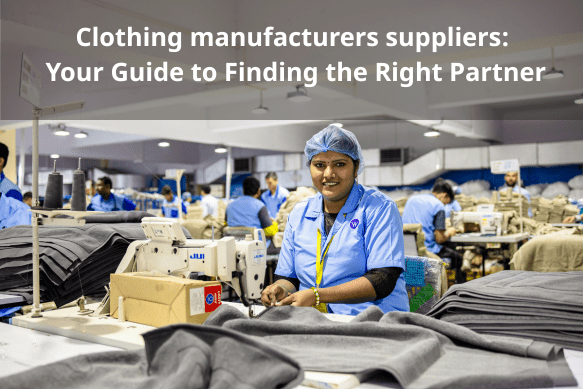Clothing manufacturers suppliers: Your Guide to Finding the Right Partner
Introduction
If you’re searching for clothing manufacturers suppliers who can handle your bulk production needs, you’ve come to the right place. As you grow your brand, finding reliable partners in Portugal and other European countries can make or break your success. In this guide, you’ll learn why choosing the right clothing manufacturers suppliers matters, how to evaluate potential partners, and what steps to take to ensure a smooth production process. By the end, you’ll have actionable strategies to secure quality, reduce costs, and scale your operations with confidence.
1. Quality Control and Compliance
When you work with clothing manufacturers suppliers, consistent quality is nonnegotiable. Here’s how to ensure it:
- Audit factory processes. Request photos, videos, or real‑time virtual tours of production lines.
- Inspect samples early. Order preproduction samples to verify materials, stitching, and fit.
- Verify certifications. Look for ISO, OEKO‑TEX, and other relevant approvals.
Real‑World Tip: ExploreTex provides detailed quality reports at each stage. Ask for mid‑production checks to catch issues before full runs.
2. Cost Efficiency and Pricing Transparency
Controlling costs starts with clear pricing from your clothing manufacturers suppliers. To negotiate effectively:
- Break down costs. Request itemized quotes for fabrics, labor, trims, and shipping.
- Compare multiple quotes. Gather at least three proposals to benchmark rates.
- Discuss volume discounts. Higher order quantities often unlock lower per‑unit pricing.
Example: If you order 1,000 T‑shirts, you might pay €5 each. Increasing to 5,000 could reduce costs to €3.80 per piece.
3. Production Capacity and Scalability
As demand grows, you’ll need clothing manufacturers suppliers who can scale with you. Evaluate capacity by:
- Reviewing factory size. Larger facilities generally handle bigger orders without delays.
- Asking about lead times. Confirm how long standard runs take and if rush orders are possible.
- Checking secondary lines. Ensure backup machines and staff are available for peak seasons.
Pro Tip: ExploreTex guarantees a 30‑day turnaround for orders up to 10,000 units, helping you meet sudden spikes in sales.
4. Sustainable and Ethical Practices
Consumers demand ethical sourcing. When vetting clothing manufacturers suppliers, look for:
- Eco‑friendly fabrics. Organic cotton, recycled polyester, or Tencel options.
- Fair labor standards. Certifications like Fair Wear Foundation or SA8000.
- Waste reduction. Zero‑waste cutting techniques or fabric recycling programs.
Action Step: Request your supplier’s sustainability report. Prioritize partners who publish annual environmental impact data.
5. Technical Expertise and Specializations
Finding clothing manufacturers suppliers with the right technical know‑how can elevate your designs. Consider:
- Specialized machinery. Laser cutters, embroidery machines, or digital printing equipment.
- Skilled workforce. In‑house pattern makers, sample makers, and quality managers.
- R&D capabilities. Ability to develop custom fabric blends or unique finishes.
Case Study: A performance‑wear brand worked with ExploreTex to integrate moisture‑wicking yarns, improving comfort and sales.
6. Supply Chain and Logistics Efficiency
Delays in shipping can stall your entire operation. Keep your supply chain smooth by:
- Choosing local hubs. Proximity to major ports or airports in Portugal, Spain, or Poland.
- Consolidating shipments. Combine orders to reduce per‑unit freight costs.
- Tracking in real time. Use cloud‑based logistics platforms to monitor shipments end to end.
Tip: Negotiate “door‑to‑factory” pricing so your supplier handles inland transport to the factory door.
7. Communication and Collaboration
Strong relationships with your clothing manufacturers suppliers hinge on clear communication:
- Define points of contact. Assign dedicated account managers or liaison officers.
- Use project‑management tools. Shared boards (Asana, Trello) keep tasks and deadlines transparent.
- Schedule regular check‑ins. Weekly video calls help address questions before they become problems.
Example Workflow: Send weekly status reports and hold monthly performance reviews to align expectations.
8. Lead Times and Minimum Order Quantities
Balancing lead times against your inventory needs requires precise planning:
- Calculate reorder points. Factor in production, shipping, customs, and buffer stock.
- Negotiate MOQs. Smaller brands might need lower minimums—ask for trial runs of 200–500 units.
- Plan for peak seasons. Confirm if your clothing manufacturers suppliers can handle holiday or back‑to‑school demand.
Quick Tip: Keep a rolling 3‑month forecast to share with your supplier, reducing the risk of stockouts.
9. Innovation and Customization Capabilities
To stand out, you may need unique elements beyond basic cuts:
- Custom trims and labels. Branded buttons, woven labels, or signature hardware.
- Advanced finishes. Water‑repellent coatings, bio‑wash effects, or UV protection treatments.
- Collaborative design. Partner with your supplier’s in‑house designers to refine patterns.
Real‑World Insight: ExploreTex’s design team can co‑create seasonal capsule collections, saving you time and ensuring coherence.
10. Location Benefits for European Markets
Working with clothing manufacturers suppliers in Europe offers distinct advantages:
- Faster shipping. Shorter distances to EU customers cut transit times and costs.
- Higher compliance. EU‑based factories adhere to strict labor and environmental regulations.
- Cultural alignment. Design trends and quality expectations often match your target markets.
Actionable Advice: Prioritize suppliers within the EU to benefit from tariff‑free trade and streamlined customs procedures.
Manual Keyword Insertion
Insert your list of secondary keywords here exactly as provided.
Conclusion
Choosing the right clothing manufacturers suppliers can transform your brand’s growth trajectory. By focusing on quality control, transparent pricing, scalability, sustainability, and clear communication, you’ll build a partnership that delivers consistent results. Remember to leverage strategic location benefits within Europe and tap into your supplier’s technical expertise for innovative customization. Now it’s your turn to apply these insights—implement these tips or explore Speed Cart to optimize your checkout experience and further boost your store conversions.
